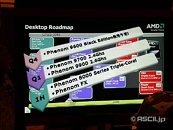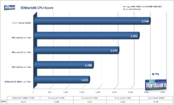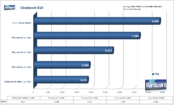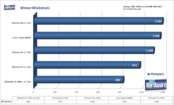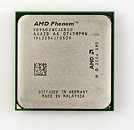News Posts matching #amd
Return to Keyword Browsing

Information coming from DigiTimes, claims that AMD will launch its next-generation performance/mainstream RS780 IGP and value RS740 chipsets in January next year, while in the second quarter, the company will launch the high-end RS780D and mainstream RS780C. RS780 motherboards will be priced around US$90-120, while RS740 motherboards will come for around US$40-60. The RS780 supports AM2+ processors, HyperTransport 3.0 and PCI Express 2.0, while the IGP will support DirectX 10 and UVD (Unified Video Decoder) 2.0 for H.264 and VC-1 decoding. The IGP also supports DisplayPort, HDMI, DVI and HDCP. Hybrid CrossFireX technology, which is a similar to NVIDIA's Hybrid SLI, allowing the IGP to work together with discrete graphics cards for extra performance, will be presented as well.

More bad news for AMD I'm afraid, this time it's in terms of company value. AMD's share price dropped to its lowest for more than four years last week, leaving the company with a total value of $5 billion US - that's $400 million less than it paid for ATI a year and a half ago. To put things into perspective, AMD's main rival Intel is worth $162 billion, which is more than 32 times more than AMD. Meanwhile, graphics card competitor NVIDIA is worth almost four times as much as AMD with a company value of $19 billion. These are tough times for AMD, and it will be hoping its Phenom processors and its HD 3000 series of graphics cards can get it out of trouble, although the former has not been particularly well received so far.

AMD announced respected industry veteran Mike Uhler, former CTO of MIPS, has joined the company as its first vice president of Accelerated Computing. Uhler has extensive experience developing advanced chip architectures and software for designs that combine multiple intellectual property (IP) blocks, as well as a deep understanding of customer requirements across a range of applications.

The lackluster launch of Barcelona earlier this year left us with ambivalent feeling before the launch of Phenom. Up before the launch, numerous rumors of various problems were circulating, and when the launch finally happened and we only had two models to play with, we couldn't help feeling a bit let down. The performance was good and lived up to what AMD had promised, more or less, but since the frequencies were so low and IPC was more or less the same as Core 2, it was still being outperformed by Intel's processors. With the recent unveiling of the TLB bug, the crippling BIOS fix and the seized shipments of quad-core processors, the plans for the future has had to be revised. The earlier announced tri-core series is set for arrival in February 2008, and should be available in decent numbers the following month. Two models are currently planned for launch, Phenom 8700 and Phenom 8600 running at 2.4 and 2.3 Ghz respectively. These are disabled quad-core with 512KB L2 cache per core and a shared 2MB L3 cache, not suffering from the TLB errata (B3 stepping).

ASUSTeK Computer has refuted industry rumors that it is planning to drop the proportion of AMD-based products of total notebook shipments next year. ASUSTeK was reported to be planning to
drop the ratio of AMD notebook platforms to 10% while increasing those of Intel. However Jellent Sun, manager of ASUSTeK's notebook division has stated that AMD's proportion will remain at 18-22%. Sun pointed out that both platforms have their own market demand and ASUS will maintain a suitable ratio to meet this demand in the future.

As many readers may be aware, there is an erratum (a mistake in the design) of AMD's recently launched Phenom CPU. Basically it's a problem with the CPU's translation lookaside buffer (TLB) and L3 cache, which can lead to crashes and data corruption. This was quickly discovered, and AMD issued a BIOS fix in response. However, recent tests carried out by The Tech Report found that as a result of this fix, memory bandwidth fell by as much as 38.7% whilst the latency increased by over 50%. When they tested the real world performance hit caused by this, they found it ranged from around 5% to as much as 50% in everyday applications, with an average performance drop of 13.9%. This issue should be fixed in any CPUs manufactured in the future, but things look quite bleak for anyone who has already purchased a Phenom processor, and it would be best not to buy one until all of the 'faulty' processors have either been sold or recalled. This is very bad news for AMD, considering that it has already been struggling to make a profit for quite a few months now.

AMD has just released a statement detailing the latest developments regarding their Quad-Core Barcelona processors.
The topics are regarding:
- For the initial ramp up "hundreds of thousands" processors were promised.
- TLB cache issues
- Quad-Core AMD Opteron availability
- AMD Opteron market share

AMD feels that the K8 architecture still has a little life in it. While Intel is working hard on 45-nm and Quad Core platforms that will cost quite a pretty penny, AMD is working on cost-effective and energy efficient solutions for the dudes that don't need or can't afford 1.21 gigawatts of processing power. To create said solutions, AMD is going to revert to an old favorite: the tried-and-true K8 architecture. After putting the K8 series through a die shrink, AMD plans to bring 11 65nm K8 CPUs to market, under the code-name Brisbane. The new 65nm variants of the K8 architecture will more likely than not require very little power to run, and will even more likely be clocked at high speeds. AMD is putting a large focus on energy efficiency, as the majority of current confirmed CPU models are flagged "Energy Efficient". All of the new 65nm K8 chips will be socket AM2, and will work in an AM2+ motherboard.

Advanced Micro Devices today said it has delayed volume shipments of its quad-core Opteron processors as it fine-tunes the chip. AMD located one bug on the L3 cache of the chip that caused system problems, said Phil Hughes, an AMD spokesman. There are a number of fixes to this problem, including a BIOS fix that AMD has issued, Hughes said. AMD is working with partners to fine-tune the chip to ready it for mass shipment in the first quarter of 2008. The quad-core Opteron, also called Barcelona, is shipping in limited quantities to customers running high-performance computers, Hughes said. The delay will affect AMD, which has already lost ground in the server chip market to Intel Corp. in recent quarters. After months of delays, AMD released the Barcelona processor in September. Intel also took a step ahead of AMD when it launched the 45-nm quad-core Penryn processors last month. AMD still manufactures chips using the 65-nm process.
Intel Corp. and Advanced Micro Devices Inc. (AMD) in the third quarter both managed to gain share in the global microprocessor market due to robust sales of PCs and servers and the cessation of the companies' brutal price war, according to iSuppli Corp.'s final ranking. In the third quarter, Intel accounted for 78.7 percent of global microprocessor revenue, up 0.3 of a percentage point from 78.4 percent in the second quarter. AMD fared even better, with its share rising by more than the twice the level of Intel's to reach 13.9 percent, up 0.6 of a percentage point from 13.3 percent in the second quarter. The two microprocessor suppliers gained at the expense of their smaller rivals, whose collective share of global revenue declined to 7.4 percent in the third quarter, down from 8.2 percent in the second quarter. Please note that this ranking accounts for sales of all types of general-purpose microprocessors, including RISC chips as well as the PC-oriented x86 devices sold by Intel and AMD.

AMD recently notified its partners that it plans to launch two triple-core CPUs (Toliman) in February next year while two dual-core CPUs (Kuma) will appear by the end of the second quarter, according to DigiTimes. The triple-core 7700 and 7600 will have core frequencies of 2.5GHz and 2.3GHz, respectively, and a TDP of 89W. Frequencies for the dual-core 6250 and 6050 have not yet been set, but the CPUs will have a TDP of 65W. In addition, AMD also plans to adjust its entry-level product lines launching the single-core Athlon CPU (Lima) LE-1640 in January of 2008, while higher frequency Lima CPUs will follow in the second quarter. The company will also launch the single-core Sempron (Sparta) CPU LE-1300 with a core frequency of 2.3GHz and TDP of 45W in the first quarter 2008.

AMD, a leading global provider of innovative processing solutions in the computing, graphics and consumer electronics markets, today announced the opening of a new silicon design and platform research and development (R&D) facility in Bangalore. As India's role and importance in AMD's global R&D network increases, the number of employees in Bangalore continues to grow, requiring a new facility that will accommodate the current team while also providing room for future growth. Employees will move into the new 52,000 square-foot center upon its completion and continue to focus on development of AMD's most advanced, next-generation processing solutions.

More bad news about AMD. According to the research firm iSuppli Intel will increase its market share by the end of 2007 to 12.5 percent, keeping its place as the world's top chipmaker, while rival AMD will drop out of the top 10. Samsung Electronics will remain the world's second-biggest chipmaker with 7.4 percent of the market while Toshiba will rise to third place, pushing Texas Instruments to number four, iSuppli said. Infineon will rise from 15th to 10th place thanks to its wireless business.
Intel successfully defended much of the market share that it won from AMD in the first quarter in the PC microprocessor segment due to the success of its lines of dual- and quad-core chips,
said iSuppli's head of market intelligence, Dale Ford. Read the full report at
eWeek.

Scott Wasson is the proud owner of the hardware review site Tech Report. Much like techPowerUp!, the Tech Report seeks to review new hardware for informative purposes. However, he recently had some choice words to say about AMD, and how many product he's allowed to test from them: almost none. Wasson, in an editorial, chastises AMD for not letting review sites get their hands on new products before, or sometimes even after, a hardware launch. Wasson claims that when a company does this to a reviewer, it's "a classic and sure-fire indicator of a poor product." Wasson claimed that even Intel, who certainly had their fair share of not-so-hot products (namely, the Prescott series) was more than happy to provide a review sample of new products. Wasson concludes his editorial by saying AMD "would do well to handle its struggles with similar grace and class". Please follow the source link for the full editorial.

Moving towards a fab-lite strategy, Advanced Micro Devices Inc. (AMD) is working on a long-awaited foundry deal with Taiwan Semiconductor Manufacturing Co. Ltd. (TSMC), according to a report from Barron's. The report cites two investment banking firms as its source, including Caris & Co. and Lehman Brothers. According to the report, AMD could have some of its processors made on a foundry basis by TSMC "as soon as the 2008 first half". At present, AMD makes the bulk of its processors in house, but also has a foundry alliance with Chartered Semiconductor Manufacturing Pte. Ltd. of Singapore. The move is geared to cut costs and offset ongoing losses. AMD is also said to be holding discussions about selling its new Fab 38 plant in Germany to TSMC.

AMD announced the appointment of Phil Rogers to AMD Corporate Fellow. In this role, Rogers will continue developing advanced architectures and extend AMD's software capabilities. Rogers' emphasis on enhancing graphics processing unit (GPU) and central processing unit (CPU) interoperability through software and hardware innovations plays a central role in delivering performance optimization and power reduction advances for graphics and computing. Corporate Fellow is the highest level of technical recognition at AMD, and is reserved for those who impact AMD's business opportunities and technical breadth by providing a high degree of expertise, knowledge, creativity, and tactical and strategic direction.

According to a press event held in Japan, AMD is planning on releasing a Black Edition of its quad-core Phenom 9600 processor. It will go on sale by the end of the year and it's obvious that the Black Edition Phenom will offer unlocked multiplier. In addition, Phenom 9700 (2.4GHz) and Phenom 9900 (2.6GHz) will be available in 1Q 2008. The first triple core Phenom 8000 series and Phenom FX will also be announced in 1H of 2008.

AMD Phenom X3 is supposed to fill the gap between today's dual-core and quad-core processors. First results with the new line of CPUs emerged earlier this weekend. The German site
PCGamesHardware has tested AMD Phenom X3 working at 2.3GHz using AMD 790FX motherboard, 2x1GB PC2-6400 RAM (CL5-5-5-15), one NVIDIA 8800 GTX OC (626MHz core, 1458MHz shader and 1000MHz memory) and Windows Vista 32-bit OS.

Nothing confirms a graphics card's existence quite like pictures. HKEPC, along with some confirmed facts as to what we can expect to see from and when we can expect to see an HD 3600, published the first HD 3600 picture. Here are the confirmed facts:
- The RV635 will be a 55nm part.
- The RV635 will run DirectX10.1, have Shader Model 4.1, and be fully compatible with PCI Express 2.0.
- The RV635 will have 24 Stream Processors, 120 Stream Processing Units (ALU), 16 Texture Address Units, eight Texture Filter Units and four ROPs.
- The RV635 will be paired with an unknown quantity of 128-bit GDDR2/3/4 VRAM.
- The RV635 will be split into two groups, the XT and PRO. The RV635XT will be dubbed the HD 3670, and will be clocked at 800/1600 core/memory, respectively. The RV635PRO will be dubbed the HD3650, and clocked at 650/1000 core/memory, respectively.
- The RV635 will begin mass-production in mid-December, and begin shipping in January.

It's pretty obvious that nowadays, gamers want more than just pretty graphics in their games. The likes of Crysis, Half Life 2, Call of Duty 4 and BioShock all show that gamers really crave and enjoy realistic physics in their games. To make rendering physics easier, and to compete with Ageia's PhysX, both AMD and NVIDIA planned out physics rendering via the graphics card. Unfortunately for both of their plans, Havok is soon going to release the Havok FX engine. The Havok FX engine is responsible for calculating physics without any GPU support whatsoever, regardless of brands. If Havok FX is adopted across the board, then the prospect of GPU physics is off-limits until at least DirectX11. This is great news for Ageia, which would leave physics to physics processing units, and very bad news for AMD and NVIDIA, who have likely been perfecting their physics engines for the past two years.

While the HD 3800 series is already available at a relatively low price (the 3850 has an MSRP of $180USD, while the 3870 has an MSRP of $220USD), AMD is considering cutting the price down to even lower amounts. There is no word as to how low AMD will go, but cheap, high power graphics cards just in time for Christmas may be exactly what AMD needs to re-claim market share from NVIDIA and their $300 8800GT. AMD increased their market share with a similar maneuver last year, by releasing value-oriented and powerful X1950 and X1650 graphics cards. This move increased AMD's market share by 2.1%, giving them 23% market share this time
last year. NVIDIA has their own plans to get holiday sales, and hopes to churn out enough G92 chips to meet demand.

When AMD released the HD 3800 series of graphics cards, most people were expecting some lower end parts for those who could not afford the $170-$230 it would cost to get an HD 3800 on Newegg. AMD's response to this is the RV635 and RV620. As stated previously there will be an RV635 XT and an RV635 PRO. The RV635 XT will be officially named the HD 3670, and the RV635 PRO will be officially named the HD 3650. Much like the current HD 2600 series, the HD 3600 series will have 24 stream processors, 120 stream processing units, 16 Texture Address Units, 8 Texture Filter Units, 4 ROPs and a 128-bit memory interface. The current revision, A11, shows that the HD 3670 will run at clocks of 800MHz core and 1.6GHz memory. The HD 3650 will have core/memory clocks of 600/1000MHz, respectively. You can expect these cards to be sampled in December, and released in January, or early February at the latest. The main thing separating the HD 3600 series from the HD 2600 series is CrossFire X support, as well as all the main perks of an HD 3800: Avivo HD, DirectX10.1, UVD, and ATI PowerPlay.

Issues with AMD's new 65nm processors are not only dampening the launch schedule of the highest frequency version Phenom CPU, but may now also affect the 2.4GHz 9700 model as well, according to DigiTimes. Phenom 9500 and 9600 CPUs launched on November 19 at US$251 and US$283, respectively, and AMD was earlier reported to be planning to launch a 9700 model in mid December. However, this schedule is now likely to be pushed back to early 2008. The delay of the higher-end CPUs is not the only disappointment expressed by the industry players as the thermal design power (TDP) of the upcoming 9700 is also drawing concern. Motherboard makers revealed that the 9700 will have a TDP of 125W while the the 2.6GHz 9900 model will have its TDP hit as much as 140W. AMD was unavailable for comment at the time of publication.

When Intel announced plans to
buy out Havok back in September, AMD began talking to Havok themselves to try and get the physics company in their hands. Talks faltered when Intel offered Havok $100 Million USD, and Intel acquired Havok and a lot of Intellectual Property. Not one to be left in the dust, AMD is currently in talks with Ageia. If Ageia offers AMD a reasonable price, they will be more than happy to acquire it. After all, according to AMD's head of developer relations, "I would say that they [Ageia] would probably grind themselves out of business in a year or so, but now they have an opportunity to sell themselves for a lot of money instead". If AMD does end up acquiring Ageia, they will get quite a lot of Intellectual Property, a new market segment, and an advantage for AMD developers. If talks falter, though, Ageia would more likely than not receive offers from the likes of NVIDIA, Sony, and several other hardware/software developers.

Things are indeed looking up for AMD as of late. NVIDIA recently unveiled plans to adapt the AMD MCP78S chipset into their motherboards, which will enable some CrossFire X features on NVIDIA chipsets. The first feature to run on these new hybrid motherboards is Hybrid SLI. Like Hybrid CrossFire, Hybrid SLI will allow for the dynamic switching of onboard and independent graphics. During normal operation, the computer will run off onboard graphics, saving energy. When the user pops in an extreme game, the machine will automatically switch graphics operations over to the much more powerful graphics card. These features will be stuck into select upcoming NVIDIA
nForce 780i motherboards, which will support Socket AM2 and AM2+ CPUs over a 2600MT/s HyperTransport 3.0 bus, six 3Gb/s SATA drives, 12 USB ports and Gigabit Ethernet.


